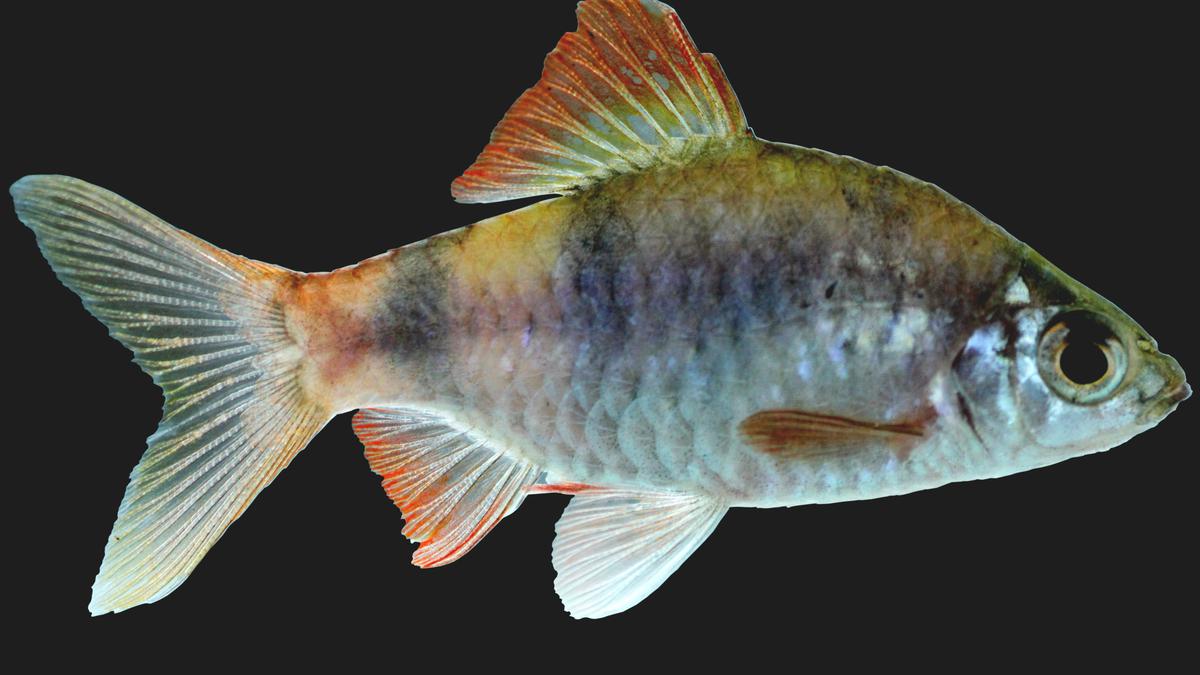
Kufos succeeds in captive breeding of threatened Indian ornamental fish
The Hindu
Kufos scientists develop artificial breeding technology for Indigo barb, a threatened species native to western India. Tech enables production of 75-100 young fish from a mother fish, providing alternative livelihoods to local communities. Project funded by Kerala govt. Plan fund. Handed over to CCARI Director Parveen Kumar by Kufos Director of Extension Daisy C. Kappan.
Scientists at the Kerala University of Fisheries and Ocean Studies (Kufos) have developed artificial breeding technology of Indigo barb (Pethia setnai), an ornamental fish native to the western part of India, which is under threat of extinction due to overfishing.
The Indigo barb is a species of great visual attractiveness, characterised by the presence of two vertical bands in its olive-grey body. It was found in freshwater streams in Goa and Karnataka. The rare species fetches around $3 per fish seedling in the international ornamental fish market. Due to the high demand among ornamental fish lovers across the world, the species has been subjected to unregulated aquarium trade and its natural habitat is under pressure from tourism, urbanisation, and agricultural pollution. The fish is included in the threatened category of the International Union for Conservation of Nature (IUCN) Red List.
The scientists at Kufos, in collaboration with the Central Coastal Agricultural Research Institute (CCARI) in Goa, conducted a two-year research to develop artificial breeding technology for Indigo barb. The research was led by Anvar Ali, assistant professor in the department of Fisheries Resources Management at Kufos.
The team was supported by CCARI with the supply of brood stock fishes (parent fishes) collected from freshwater streams in the backwaters of Goa. The team successfully developed the artificial breeding technology from experiments held at the Kufos hatchery. The species was bred in captivity with and without hormone induction in indoor and outdoor systems and the larvae were developed in mixed zooplankton culture.
Using this simple, farmer-friendly technology, it is possible to produce more than 75-100 young fish from a mother fish. Dr. Ali said fish farmers had to use an 80-day-long process to produce Indigo barb seedlings in artificial ponds in a commercial manner and bring them to the market. The package of practices for the seed production of Indigo barb developed by Kufos would provide alternative livelihood opportunities to the local communities in Goa and eventually in other regions of the country, said a communication from Kufos here.
The project implementation unit at Kufos was supported by the Kerala government through its Plan fund. Apart from Dr. Ali, the research team consisted of Melbinlal, junior research fellow, CCARI scientist Sreekanth G.B., and Trivesh Mayekar.
The seeds produced at the Kufos hatchery were handed over to CCARI Director Parveen Kumar by Kufos Director of Extension Daisy C. Kappan. Faculty members Radhika Rajasree, K. Ranjeeth, M.P. Safeena, Anu Gopinath and M.S. Raju were present.

We know birds, animals and insects constantly communicate with each other by making certain sounds. But when we think about plants, we do not ever think of them communicating. Charles Darwin, an eminent biologist, thought otherwise. Plants might appear the quiet, silent and solitary type of organisms but they have a complex way of communicating which is interesting and important for their survival.

Podcasts have become our best friends, especially during the Covid-19 pandemic. Whether you are cooking, sketching or going on an evening walk, there is a show that matches your mood. From horror tales to informative conversations to just two friends talking about anything & everything relatable, podcasts have become a part of our lives unknowingly. Over the years, more voices have joined this audio landscape and filled it with stories that resonate with our lives. Podcasts serve as a reminder that everyone has a story worth telling and listening to!









